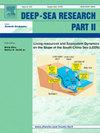Diatom assemblages in coral patches of the Northwestern Persian Gulf: Community structure across substrates and proximity to oil sites
IF 3
3区 地球科学
Q2 OCEANOGRAPHY
Deep-sea Research Part Ii-topical Studies in Oceanography
Pub Date : 2025-09-01
DOI:10.1016/j.dsr2.2025.105535
引用次数: 0
Abstract
Diatoms, essential primary producers in coral reef ecosystems, are highly sensitive to environmental changes, making them effective bioindicators of ecosystem health. This study investigates diatom assemblages in northwestern Persian Gulf coral reefs, comparing communities in oil-polluted sites around Kharg Island with those in less-impacted conditions near Khargoo Island. A total of 86 diatom taxa from 37 genera were identified across live and dead coral tissues and coral rubble. The most abundant species across all samples (average ± SD) were Halamphora coffeiformis (8.43 ± 1.4 %), Nitzschia dissipata (5.94 ± 2.11 %), and H. borealis (5.75 ± 1.39 %). Statistical analyses revealed that substrate type significantly influenced species richness, with dead corals hosting more diatom species than live corals and coral rubble. While no significant difference in species richness was observed between the oil-polluted and control sites, the assemblages differed compositionally. Diatom communities growing on living corals from the polluted site showed the highest level of within-group dissimilarity, which may indicate habitat instability and a state of dysbiosis. These findings suggest that community differences may be associated with chronic oil exposure, and that substrate type plays an important role in shaping diatom communities. The results also signal the potential of certain diatom species as indirect bioindicators responding not only to the pollutants present at the sampling location but also to the condition of a possibly more sensitive host. Further research is needed to assess the long-term effects of oil pollution on coral reef health and diatom-coral interactions.
波斯湾西北部珊瑚斑块中的硅藻组合:跨底物和靠近石油点的群落结构
硅藻是珊瑚礁生态系统重要的初级生产者,对环境变化高度敏感,是生态系统健康的有效生物指标。本研究调查了波斯湾西北部珊瑚礁的硅藻群落,比较了哈尔格岛周围受石油污染的地区和哈尔格岛附近受影响较小的地区的群落。在活珊瑚、死珊瑚组织和珊瑚碎石中共鉴定出37属86个硅藻类群。在所有样本中丰度最高的物种(平均±SD)分别为:黑腹虫(8.43±1.4%)、耗散Nitzschia(5.94±2.11%)和北方黑腹虫(5.75±1.39%)。统计分析显示,基质类型显著影响物种丰富度,死珊瑚比活珊瑚和珊瑚碎石承载更多的硅藻物种。油污染样地与对照样地物种丰富度差异不显著,但群落组成存在差异。生长在受污染地点的活珊瑚上的硅藻群落表现出最高的群内差异,这可能表明生境不稳定和生态失调状态。这些发现表明,群落差异可能与长期油暴露有关,并且底物类型在硅藻群落的形成中起重要作用。研究结果还表明,某些硅藻物种具有作为间接生物指标的潜力,不仅对采样地点存在的污染物作出反应,而且对可能更敏感的宿主的状况作出反应。需要进一步的研究来评估石油污染对珊瑚礁健康和硅藻-珊瑚相互作用的长期影响。
本文章由计算机程序翻译,如有差异,请以英文原文为准。
求助全文
约1分钟内获得全文
求助全文
来源期刊
CiteScore
6.40
自引率
16.70%
发文量
115
审稿时长
3 months
期刊介绍:
Deep-Sea Research Part II: Topical Studies in Oceanography publishes topical issues from the many international and interdisciplinary projects which are undertaken in oceanography. Besides these special issues from projects, the journal publishes collections of papers presented at conferences. The special issues regularly have electronic annexes of non-text material (numerical data, images, images, video, etc.) which are published with the special issues in ScienceDirect. Deep-Sea Research Part II was split off as a separate journal devoted to topical issues in 1993. Its companion journal Deep-Sea Research Part I: Oceanographic Research Papers, publishes the regular research papers in this area.

 求助内容:
求助内容: 应助结果提醒方式:
应助结果提醒方式:


